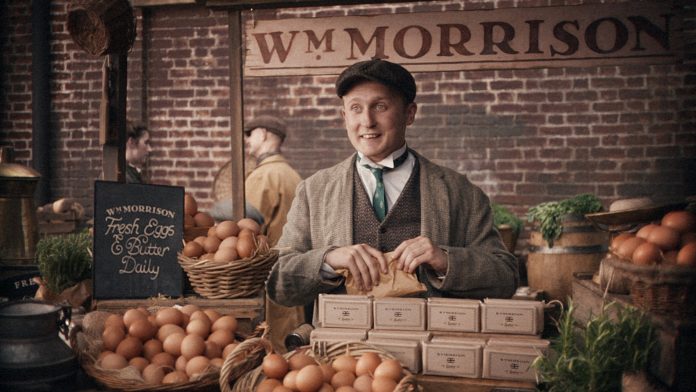It’s not easy making a ketchup bottle famous: Robert Volten explores what supermarkets can learn from the fast movers
Remember when doing the weekly shop was a simple 10-minute dash?
Shoppers knew their favourite brands like the back of their hand, and could spot them on the shelves at 20 paces – whether it was Heinz, Hovis or Häagen-Dazs.
Fast forward to 2024 and the aisles look a little different. Private-label products are vying for attention, and a spot in the basket, alongside supermarkets’ own-brand products. Factor in inflated prices and it’s no wonder that competition for eyeballs is heating up.
So how can retailers respond and stand out in a market where brand storytelling and product advertising are rapidly evolving? The first step? Build their own brand identity that goes beyond the emotional narrative that has been the advertiser’s crutch for too long.
Building brand awareness, as a supermarket, is one thing. But product ads are an entirely different kettle of fish – one that requires an additional strategy and creative direction. One that some fast movers are setting the bar for.
Distinction
Standing out is more critical than ever.
In my home country of the Netherlands, stark contrasts can be drawn from that of the UK FMCG landscape. Not only are there only two serious players, the battle that engrosses them is based solely on price and price alone. Convenience or more importantly, quality doesn’t even come into dispute.
But in the UK, Supermarkets now face the challenge of earning consumer loyalty in an era where shoppers are increasingly focused on either finding the cheapest products AND the best quality. Instead of merely offering competitive prices, supermarkets need to build a brand that shoppers love and enhance their loyalty strategies by learning from the brands on their own shelves.

With fierce competition from disrupters like Aldi and Lidl and tough economic hits to consumers’ spending habits, supermarkets are working harder to get shoppers through their doors by waging a race to the bottom on price.
Since Aldi’s entrance into the UK market in 1990, and Lidl four years later, the small but mighty discount shops have been nipping at the heels of the Big Four. Disruptors paved their success by not only promising competitive pricing but by also disseminating what it meant to be a loyal shopper. Suddenly, the weekly shop became divided as consumers hopped and skipped between retailers to find the best deals for the Sunday roast, even if it meant buying the chicken from one shop and your spuds from another. Ever since, supermarkets have lost all meaning of loyalty in a bid to compete on price, as Aldi ironically called out in a recent ad, begging the question – when did competing on quality go out the window?

Asda’s focus on price comparison ads lacks any distinctive flair and highlight just how tit-for-tat the industry has become. Where their ads might remind consumers to check their receipts, it fails to leave a lasting impression or distinguish their products from the rest.
Sure, they show off a few cheaper-priced products on their own shelves, but is that enough to build loyalty? To build a recognisable brand? To make shoppers want to shop in their stores because they love Asda, its products AND they can slim down their weekly spending?
If I’m honest, it’s not just Asda that’s experiencing an identity crisis and missing the point altogether. It appears many UK retailers are more concerned about pointing out price discrepancies than delivering a tantalising expression of how the quality of their products makes them worthy of our loyalty. So what better place to start than with their own-brand products? That’s where their roots are and where the brand’s true identity can be unleashed after all.
Don’t be boring
Granted, product advertising isn’t typically the stuff that wins awards or gets industry pats on the back. Hence why there’s a severe lack of creativity in product ads. But product ads don’t need to be dull. Yes, I’m serious. There’s nothing dull about last year’s best-in-class product ad from Reese’s and there’s no reason why supermarkets can’t aspire to be the same.
To give credit where credit’s due, M&S does just that. Their memorable food ads exemplify the power behind effective product-first campaigns. They master the art of creating a distinctive brand identity by vividly showcasing their mouth-watering products. Take their Valentine’s food advert, the rich sauce pouring slowly over a perfectly cooked steak to a sultry soundtrack. It’s a sensory delight that’s unmistakably M&S. They are pioneers in using their own products to craft a distinct identity, setting themselves apart from the competition with each frame. It’s more than just an ad; it’s an experience that makes you crave more. More M&S, more mouthwatering, juicy steak – just more.
By creating an immersive and sensory experience that oozes from our TV screens as if we’re watching Smell-O-Vision, M&S make you crave not just any steak, but that specific M&S steak. They elevate the supermarket brand identity and that is quite frankly, a bar yet to be matched by many other UK supermarkets.
In a similar thread, there’s something similarly as masterful about Tesco’s Food Love Stories where the real and relatable tales depict how something as fundamental as food has the power to create far more than fundamental impacts on our lives. In their own way, both M&S and Tesco champion the indulgent storytelling technique. It’s this ‘iconicness’, trailblazed by unique products, that needs widespread adoption; but without widespread repetition.
Competition only need take a look at some of the household name brands on their own shelves for more inspiration. From Reese’s unique yet identifiable sprinkling of humour in their ads to arguably the most iconic item on every household shelf – Heinz ketchup. There’s a reason Heinz has been a staple in millions of homes around the world since 1876. It’s more than just a sauce. It represents quality, tradition and a legacy of loyalty wrapped up in an iconic glass bottle.

Making said product iconic, is no mean feat. It requires creative storytelling that seamlessly weaves the product into our homes and lives, generation after generation. It makes consumers crave, need and demand that ‘it has to be Heinz’. But a cautionary word to retailers: do not be mistaken and think this is easy. You might have made a nice brand campaign a few years ago, but your product ads still need their own strategy. Try taking it right back to your core brand and trust that it requires more than a few seductive shots. In such a competitive landscape, you can’t rely on price, quality or convenience to shift boxes. It’s about building beloved products first that in turn, make you a beloved brand.
Take Morrisons. With creative storytelling and products at its core, Morrisons marked its 125 years in business this year by championing its deep British food heritage. Spotlighting over-the-counter chatter from years past (see top image and below), its latest ad shows that while a lot has evolved in customers’ lives since opening in 1899, their passion for Morrisons’ great quality fresh food has never wavered.
It’s this long-standing brand heritage that is Morrisons best and most powerful tool that must too be incorporated into its regular product advertising. It evokes trust, reliability and a sense of nostalgia, all qualities that are invaluable in building product loyalty.

From its hero farmers to the local, fresh British food on our table, Morrisons is triumphant in showing why its brand is unique among the sea of sameness, but what about its products? Its ads are where it can really shine with its distinctive flare, offering all the “more reasons to shop at Morrisons”. What makes Morrisons, Morrisons, is the heritage of the brand and craftsmanship of its products so why not tell both tales in tandem.
Start thinking like a marketer
In the same way FMCG brands battle it out for our attention, supermarket retailers are facing a similar salience game, making it crucially important for own-brand products to have their own defining identity.
Big brand moments, yes, like the dazzling Christmas ads are crucial for building supermarket brand identity and capturing the festive spirit. But the fun shouldn’t stop there.
For effective product advertising, mid-funnel marketing is just as important as the big once-a-year brand moments. It deserves the space, time and investment. When less than one in five brand assets are truly distinctive, the majority of what consumers see is just white noise. So, it’s just as important to show up with flare during the other 11 months of the year. Use food as your differentiator and watch how the brand sticks in the minds of your consumers. And walks itself into shoppers’ baskets.
Don’t be that guy who turns up to a fancy-dress party in jeans and a T-shirt because you didn’t fancy making an effort. To stand out, every touchpoint should be dressed to impress. That’s the magic of making every marketing asset count – it turns routine customer encounters into memorable brand experiences.
Use your secret ingredient
In the crowded aisles of UK supermarkets, standing out is more than just a well thought out Christmas strategy. It’s a necessity 364 days of the year and imperative across every touchpoint from the TV screen to the product packaging itself. And yet many still struggle to find their secret ingredient.
Distinction is the sugar and spice that adds all things nice to a supermarket’s identity, making it memorable in the minds of its shoppers. Whether it’s through clever storytelling, bold product visuals, or a unique voice, distinctive product advertising is the tool to create a connection with customers, turning routine shopping trips into loyal experiences and further driving distinction. In the sea of sameness that is the UK supermarket aisles, it’s the brands that dare to be different that truly resonate and thrive.
Robert Volten is Business Lead at Chuck Studios





